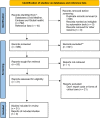Resource use, availability and cost in the provision of critical care in Tanzania: a systematic review
- PMID: 36414306
- PMCID: PMC9684998
- DOI: 10.1136/bmjopen-2021-060422
Resource use, availability and cost in the provision of critical care in Tanzania: a systematic review
Abstract
Objectives: Critical care is essential in saving lives of critically ill patients, however, provision of critical care across lower resource settings can be costly, fragmented and heterogenous. Despite the urgent need to scale up the provision of critical care, little is known about its availability and cost. Here, we aim to systematically review and identify reported resource use, availability and costs for the provision of critical care and the nature of critical care provision in Tanzania.
Design: This is a systematic review following the Preferred Reporting Items for Systematic Reviews and Meta-Analyses guidelines.
Data sources: Medline, Embase and Global Health databases were searched covering the period 2010 to 17 November 2020.
Eligibility criteria: We included studies that reported on forms of critical care offered, critical care services offered and/or costs and resources used in the provision of care in Tanzania published from 2010.
Data extraction and synthesis: Quality assessment of the articles and data extraction was done by two independent researchers. The Reference Case for Estimating the Costs of Global Health Services and Interventions was used to assess quality of included studies. A narrative synthesis of extracted data was conducted. Costs were adjusted and reported in 2019 US$ and TZS using the World Bank GDP deflators.
Results: A total 31 studies were found to fulfil the inclusion and exclusion criteria. Critical care identified in Tanzania was categorised into: intensive care unit (ICU) delivered critical care and non-ICU critical care. The availability of ICU delivered critical care was limited to urban settings whereas non-ICU critical care was found in rural and urban settings. Paediatric critical care equipment was more scarce than equipment for adults. 15 studies reported on the costs of services related to critical care yet no study reported an average or unit cost of critical care. Costs of medication, equipment (eg, oxygen, personal protective equipment), services and human resources were identified as inputs to specific critical care services in Tanzania.
Conclusion: There is limited evidence on the resource use, availability and costs of critical care in Tanzania. There is a strong need for further empirical research on critical care resources availability, utilisation and costs across specialties and hospitals of different level in low/middle-income countries like Tanzania to inform planning, priority setting and budgeting for critical care services.
Prospero registration number: CRD42020221923.
Keywords: health economics; health policy; intensive & critical care.
© Author(s) (or their employer(s)) 2022. Re-use permitted under CC BY. Published by BMJ.
Conflict of interest statement
Competing interests: None declared.
Figures
Similar articles
-
Resource availability, utilisation and cost in the provision of critical care in Tanzania: a protocol for a systematic review.BMJ Open. 2021 Aug 25;11(8):e050881. doi: 10.1136/bmjopen-2021-050881. BMJ Open. 2021. PMID: 34433607 Free PMC article.
-
Beyond the black stump: rapid reviews of health research issues affecting regional, rural and remote Australia.Med J Aust. 2020 Dec;213 Suppl 11:S3-S32.e1. doi: 10.5694/mja2.50881. Med J Aust. 2020. PMID: 33314144
-
Hospital readiness for the provision of care to critically ill patients in Tanzania- an in-depth cross-sectional study.BMC Health Serv Res. 2024 Feb 8;24(1):182. doi: 10.1186/s12913-024-10616-w. BMC Health Serv Res. 2024. PMID: 38331742 Free PMC article.
-
Behavioural modification interventions for medically unexplained symptoms in primary care: systematic reviews and economic evaluation.Health Technol Assess. 2020 Sep;24(46):1-490. doi: 10.3310/hta24460. Health Technol Assess. 2020. PMID: 32975190 Free PMC article.
-
Association of Surrogate Decision-making Interventions for Critically Ill Adults With Patient, Family, and Resource Use Outcomes: A Systematic Review and Meta-analysis.JAMA Netw Open. 2019 Jul 3;2(7):e197229. doi: 10.1001/jamanetworkopen.2019.7229. JAMA Netw Open. 2019. PMID: 31322688 Free PMC article.
Cited by
-
A health systems approach to critical care delivery in low-resource settings: a narrative review.Intensive Care Med. 2023 Jul;49(7):772-784. doi: 10.1007/s00134-023-07136-2. Epub 2023 Jul 10. Intensive Care Med. 2023. PMID: 37428213 Free PMC article. Review.
-
Assessing Barriers to Primary Prevention of Cardiovascular Diseases in Low and Middle-Income Countries: A Systematic Review.Cureus. 2024 Jul 27;16(7):e65516. doi: 10.7759/cureus.65516. eCollection 2024 Jul. Cureus. 2024. PMID: 39188440 Free PMC article. Review.
-
Cost Effectiveness of Strategies for Caring for Critically Ill Patients with COVID-19 in Tanzania.Pharmacoecon Open. 2023 Jul;7(4):537-552. doi: 10.1007/s41669-023-00418-x. Epub 2023 May 13. Pharmacoecon Open. 2023. PMID: 37178434 Free PMC article.
-
Essential emergency and critical care as a health system response to critical illness and the COVID19 pandemic: what does it cost?Cost Eff Resour Alloc. 2023 Feb 13;21(1):15. doi: 10.1186/s12962-023-00425-z. Cost Eff Resour Alloc. 2023. PMID: 36782287 Free PMC article.
-
The Pattern of Admission, Clinical Characteristics, and Outcomes Among Patients Admitted to the Intensive Care Unit of a Tertiary Hospital in Tanzania: A 5-Year Retrospective Review.Patient Relat Outcome Meas. 2023 Dec 7;14:383-392. doi: 10.2147/PROM.S441293. eCollection 2023. Patient Relat Outcome Meas. 2023. PMID: 38089710 Free PMC article.
References
-
- Reynolds TA, Sawe H, Rubiano AM, et al. Strengthening Health Systems to Provide Emergency Care. In: Jamison DT, Gelband H, Horton S, eds. Disease control priorities, third edition (volume 9): improving health and reducing poverty. 3rd ed. The International Bank for Reconstruction and Development / The World Bank; 2017:247-265.10.1596/978-1-4648-0527-1_CH13. - PubMed
Publication types
MeSH terms
Grants and funding
LinkOut - more resources
Full Text Sources
Medical

